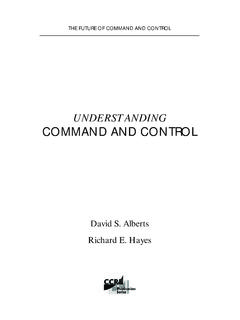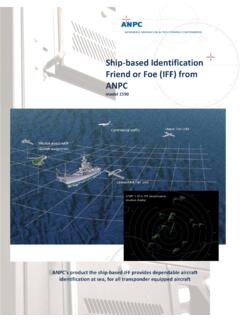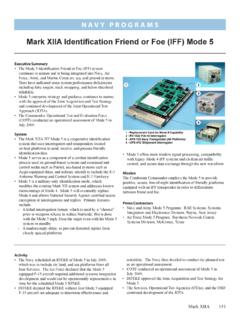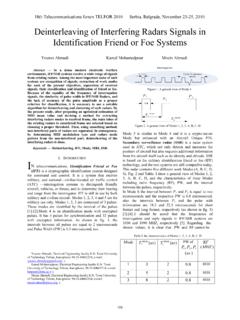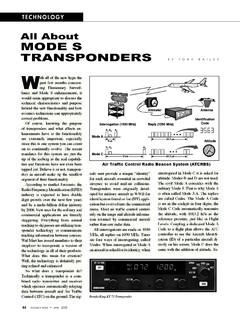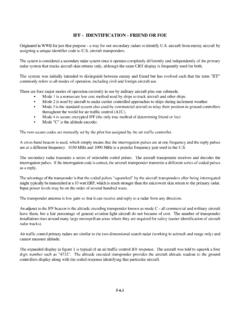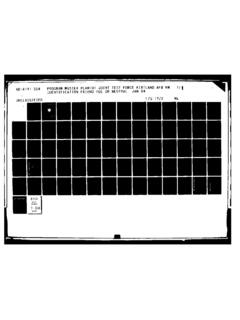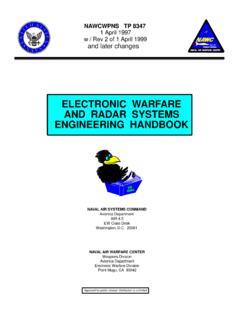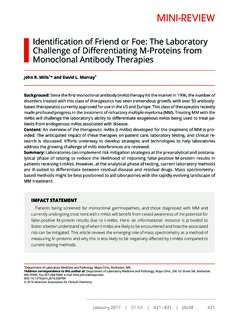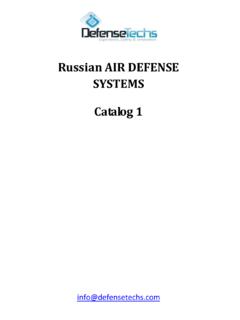Transcription of A Mathematical Theory of Identification for Information …
1 A Mathematical Theory of Identification for Information FusionTod M. SchuckLockheed Martin Naval Electronic and Surveillance Systems Surface Box 1027199 Borton Landing RoadBuilding 13000 Y202 Moorestown, NJ paper applies Shannon Theory , which was established to describe a discrete generalcommunications system, to a general Identification system that is affected by noise (andjamming), the probability of a discrete event occurring (such as an object in a certain region ofspace), and most importantly, the entropy and dissonance of the Information source. This paperanalyzes the cause of the many Identification problems currently in the military from afundamental Information perspective. This includes analysis on how sharing Information derivedfrom Identification Friend-or-Foe (IFF), Electronic Support Measures (ESM), and Non-Cooperative Target Recognition (NCTR) sensors, with measures of Information completenessand conflict, between varied military participants is essential for achieving a network-centricintegrated Identification IntroductionOver 50 years ago the seminal paper A Mathematical Theory of Communication laid thefoundation of communications Theory [Shannon, 1948].
2 Claude Shannon, while at Bell Labs in1948, developed his theories of communication based on the work of Nyquist and Hartley whopreceded him by twenty years by including the effects of noise in a channel and the statisticalnature of transmitted signals. This paper extends his analysis of communications systemproperties to Identification techniques and defines the fundamental problem of communications as that of reproducing at onepoint either exactly or approximately a message selected at another point. Further he states thatthe messages refer to or are correlated according to some system with certain physical orconceptual entities. For a subsurface, surface, airborne, or space-based object (which willhenceforth just be described by the word object ), the following correspondence definition canbe made:Correspondence 1 Identification of an object using some form of sensor informationis the process of reproducing either exactly or approximately thatobject at another s message in an Identification context is the Information received from a sensor (orsensors) that describes an object with certain physical traits.
3 Examples include whether the objecthas the intrinsic characteristics of rotors or fixed wings, a classifiable type of radar orcommunications system, a categorical thermal image, etc. For Identification purposes, theinformation in a message contains features that allow attributes to be assigned to an unknownobject that can be used to form an abstraction of the object at some level of approximation. Thusthe use of the term Identification refers to a taxonomic Identification that describes what anobject is (F/A-18, etc.) as opposed to its relationship to the identifying platform (Friend, Hostile,etc.). For most types of objects, the complete set of possible attributes that can be derived isdependent on the number, quality, and type of sensor Information providers assigned to theidentification task. In essence, whether a detected object can be classified as an aircraft or ship,bomber or airliner, B1 or 747, etc.
4 , is dependent on these sensor characteristics and their abilityto form the abstraction. This relates Identification to a communications link that will vary ineffectiveness depending on its fidelity and number of paths. This leads to a secondcorrespondence definition:Correspondence 2 Each Identification message that is received from a sensor is onethat is selected from a set of possible Identification messages,which can describe one or more possible objects or set of objectsdepending on the Information content of the number of possible messages is finite because the number of possible objects that can bereproduced by a sensor is also finite. So the selection of one message can be regarded as ameasure of the amount of Information produced about an object when all choices are otherwiseequiprobable. This is significant because it allows an assessment of whether enough informationexists to adequately describe an object, based on the number and types of identificationmessages.
5 The measure of Information content is what enables an automated process or humanoperator to determine if enough Information exists to make a decision. A derivative of theShannon Information entropy measurement, which is described later in this paper, is used tomeasure the Information content of a message or series of The Identification SystemThe one-way Shannon communication system is schematically represented in figure 1, withmodifications to incorporate elements of the sensor domain for identification1. 1 All Information associated with Shannon is reproduced or derived from reference [Shannon, 1948].Figure 1. One-Way Diagram of a General Identification System ProcessReferencing figure 1, the five parts can be described as follows:1. An Information source corresponds to something that either produces or reflects energythat is captured by a receiver and consists of a series of deterministic entities such asreflected spectra or electromagnetic emissions.
6 For Identification , the Information sourcecan provide multiple channels of Information (often orthogonal) that can be three Information domains consist of Identification Friend-or-Foe (IFF), ElectronicSupport Measures (ESM), and Non-Cooperative Target Recognition (NCTR). IFF isconsidered cooperative communication because the Information source willinglydiscloses Information about itself to a requestor. ESM is considered to be unintentionalcooperation because the Information source, in the course of its normal operations,unknowingly discloses Information about its identity based on the characteristics of itsemissions. NCTR requires no cooperation from an Information source other than itsexistence in order to derive features associated with its identity. Each of these sources canbe considered as a unique discrete function fn[t], gn[t], and hn[t] where the subscript, n,indicates multiple sensor types from each Information domain of IFF, ESM, and NCTR respectively.
7 Each of these functions forms an Identification vector that contributes to thegeneration of the abstraction of the original Information source. This is illustrated withthe series of features (similar to Information domains) of a famous celebrity shown infigure 2 (derived from [Haak, 2002] and [Hall, 2001]).Figure 2. Abstracted Information FeaturesEach set of features in figure 2 represents different Information types at similar levels ofabstraction (in this case). Each of these features can be considered as part of anidentification vector for the image (caricature) shown in figure 3. Correlated Information Features ( Identification Vector)Figure 3, in turn, is almost universally recognized as an abstraction of the photo of BobHope (the object) in figure 4. Bob Hope (object)In this example, the human brain fuses these feature vectors in order to determine theidentity of the object. Notice that not all of the Information about the object (Bob Hope)is present in figure 2 (there is no Information abstraction of the ear).
8 The assembledfeature Identification vectors in figure 3, even though they are an exaggerated abstractionof the object Bob Hope, can just as clearly represent him as the more representative photoin figure A transmitter is equivalent to an apparatus that emits some sort of radiation, or it could bea structure reflecting radiation back to a receiver. For IFF this is the transmitter of thetransponder emitting a reply. For ESM this is the radiation of either radar orcommunications system emissions. For NCTR this could be radar, infra-red (IR) or asimilar emissions being radiated or reflected. All of these domains could be transmittedsimultaneously or The channel is the medium used to carry the Information from the transmitter to thereceiver. This is the atmosphere for airborne, space, and surface objects and water forundersea (and surface) objects. Noise sources also exist that change the channelcharacteristics and include target noise, atmospheric noise, space noise, random chargenoise, etc.
9 In a tactical environment there also exists the possibility of intentional channelmodification or destruction in the form of spoofing or The receiver is the device used for converting the transmitted or reflected energy from theinformation source and passing it on to a destination. Each set of ID sensor Information ,IFF, ESM, and NCTR has a unique receiver type optimized to extract signal energy in itsrespective The destination is the process that gathers the Information from the Information sourcevia the receiver and processes it in order to extract the feature vector. This is generallythe processing performed within the sensor that results in a message about theinformation source. In the example using the caricature of Bob Hope, one sensor typemight extract the hairline , while another type might extract the chin , and still anotherhis distinctive nose .3. Forming the Identification VectorFor each sensor Information domain, the communications system is slightly different.
10 In the caseof Mk XII ATCRBS IFF there are two versions of figure 1, one each for the uplink and downlinkat 1030 and 1090 MHz respectively. For ESM there is a single channel where an object emits asignal from radar, sonar, or a communications system, which is the Information source thatprovides the sensor with its input. For NCTR, the paths are generally the same (with theexception of infra-red which is a single path like ESM) with the return path of the most interestbecause it contains the feature Information of interest to the destination processing. Each of thesesupports the formation of the object abstraction through some sort of fusion of the source of Information , just like the principles from Shannon s discretenoiseless channel system, there exists a sequence of choices from a finite set of possibilities thatcan make up a possible object. For Mk XII IFF it is the set of possible reply codes (such as 4096 Mode 3/A octal codes). For ESM it is the set of all possible emitters that can be correlated to aphysical object.


